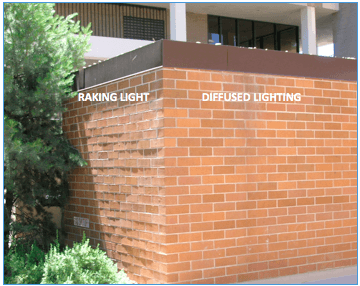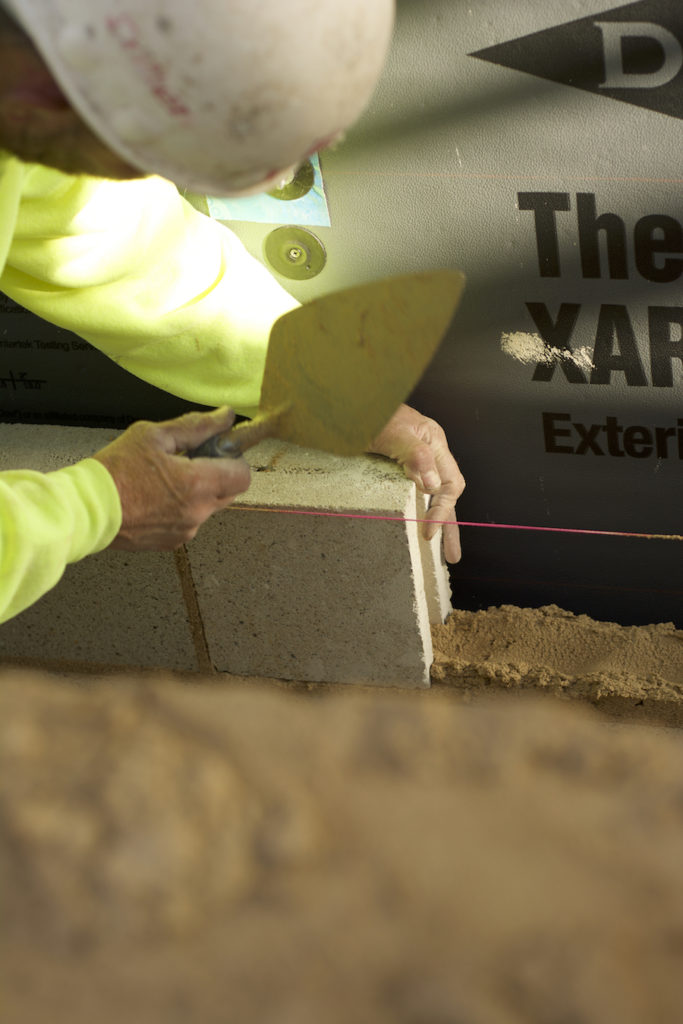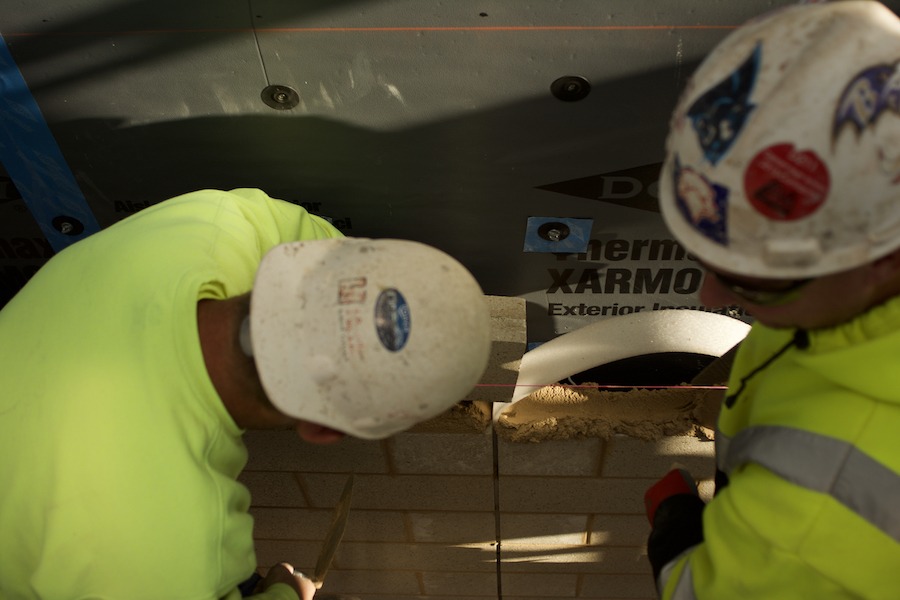On some projects it just seems that nobody can agree on wall appearance, and what looks right to one person can be unacceptable to another. There may be complaints about mortar color, joint width, or cracks and chips in the brick. Some architects like to get up close with a straightedge or a magnifying glass when evaluating a wall – but both of these approaches are wrong! Luckily there is guidance within the building code and ASTM on how to judge masonry wall appearance.
Construction tolerances.
Masonry design and construction is covered in the TMS 402 Building Code and the TMS 602 Specifications. Specifications Section 3.3. F contains a list of construction tolerances. Some designers will expect masonry veneer to meet these tolerances even though they were developed for structural reasons rather than appearance issues. Tolerances are listed in the Specification for plumb (±1/4” in 10 ft, ±3/8” in 20 feet, and ±1/2” max.), variation from level (±1/4” in 10 ft. or ±1/2” max.), and variations from a line (±1/4” in 10 ft, ±3/8” in 20 feet, and ±1/2” max.), among others.
Mortar bed joints may vary ±1/8” from the specified thickness, and head joint variations are limited to -1/4” or +3/8 inch. That means a 3/8” bed joint may range from ¼” to ½” thick, and head joints may range from 1/8” to ¾” wide and still meet tolerance requirements.
Be sure to check your project manual: some project specifications tighten up these tolerances or list tolerances for items not covered by TMS 602, such as head joint alignment up the wall.
Brick chips and cracks.
Clay brick are made to be uniform in dimension and appearance, but they do occasionally get damaged during manufacture or shipment. Brick appearance depends on brick “Type”. Type FBS brick represent standard production brick, Type FBA are made to meet special architectural or appearance criteria, and Type FBX brick have extra control during manufacture. If your project requires tight control on tolerances or appearance, consider purchasing Type FBX brick.
ASTM brick standards (including ASTM C216, the specification for veneer brick) give some allowance for the size and number of brick chips and cracks that are permitted in a brick shipment. Depending brick type, between 5 and 15 percent of your brick shipment can have small chips and cracks. ASTM standards also spell out limits on brick distortion, warpage, and dimensional variations.
One way to diffuse disputes is to make sure everyone is judging the finished product correctly. First compare the appearance to that of the approved sample panel. In-place work should have the same quality and appearance as that represented by the sample panel.
Beyond the chips permitted by ASTM, brick standards tell us that the brick “shall be free of cracks or other imperfections detracting from the appearance of the designated sample when viewed under diffused lighting from a distance of 15 feet for Type FBX and a distance of 20 feet for Types FBS and FBA” (see Photo). Brick standards in ASTM C216 and C652 both have this statement, and similar approaches for visual evaluation are included in ASTM concrete block specifications.
Tips for evaluating appearance
- Be proactive. Develop a pre-construction agreement and get everyone to agree on the desired appearance before beginning work. If you are unfamiliar with the brick specified for the project, talk to the manufacturer about their typical production tolerances.
- Sample panel. ALWAYS have the client approve a sample panel for the project. This doesn’t have to be an expensive free-standing wall panel and on many jobs the sample panel can just be the first bit of masonry constructed. The sample panel should contain the range of colors and workmanship expected on the project. Make sure everyone agrees on its appearance before proceeding with the work.
- Clean the wall first. If there is a dispute about wall appearance wait until you have a finished product before evaluating. Cleaning will change how the wall looks.
- Tooling. Be consistent with tooling. Don’t rush it, and make sure all your masons are tooling at the same mortar age. Mortar should be tooled when it is “thumbprint hard.” Tooling when the mortar is too wet or too stiff will change its color.
- Cull brick. Watch for cracked, chipped, warped, or discolored brick when you are laying up the wall. Either turn the bad face into the cavity (where it won’t be seen), cut off the damaged part and use the rest as a half brick, or throw it in the trash pile.
- Efflorescence. ASTM brick standards changed a few years ago, and now if you want a brick that does not contribute to efflorescence you have to ask for it. Require the manufacturer provide brick rated as “not effloresced” when tested according to the method of ASTM C67.
- Pay attention to cleaning. Using high pressure or acid cleaners can disfigure brick and mortar joints. Ask the brick manufacturer which cleaning solution is best for their product. Remember to prewet the wall, apply cleaners using low pressure, and don’t use high pressure or needle-tip nozzles for rinsing the wall.

Built by the same mason, using the same brick, at the same time, these 2 walls look very different. Sunlight raking down the left side highlights every little misalignment. The correct way to look at a brick wall is under “diffused” or indirect lighting, as shown on the right side.
Words: Michael Schuller
Photos: Atkinson-Noland & Associates, Masonry Magazine

